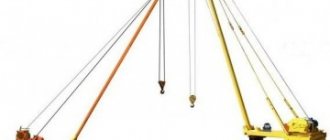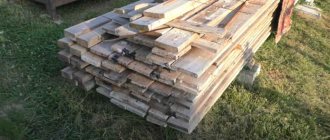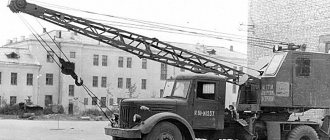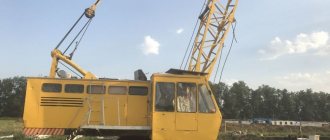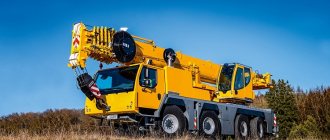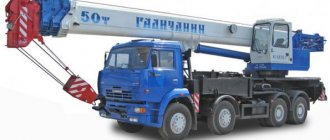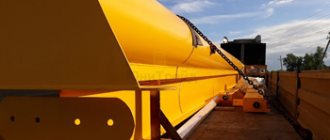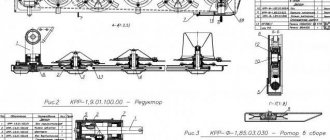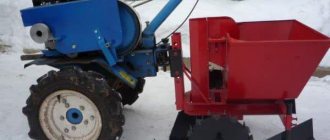Carrying out construction, installation, repair and loading and unloading work at construction sites of buildings and structures, warehouses, bases of trading enterprises and landfills is impossible without the use of specialized lifting equipment.
The Pioneer jib crane is a widely used model for general industrial use. The device easily supplies building and roofing materials, roofing felt, insulation, and tools to the roof, and moves machines and elements of installation structures. The mechanism can be operated both at low temperatures down to -40°C and up to +40°C.
Crane Pioneer capacity 1000 kg
The immediate and direct purpose of the Pioneer crane with a lifting capacity of 1000 kilograms is to move and lift the necessary cargo during construction and repair work to the required height. The Pioneer crane is installed on the roof of a building or on a ceiling; it is also possible to lift loads from the ground.
The Pioneer crane with a lifting capacity of 1000 kg (tonner) is a structure that consists of a rotating platform on which a rope winch is located, the boom of the Pioneer crane, couplers for the boom, a hook suspension, a triangular support frame, reinforced concrete counterweights, as well as electrical equipment.
An electric drive is used to move the load and rotate the frame and therefore does not require additional physical effort.
Unlike the Pioneer crane with a lifting capacity of 500 kg, where counterweights are hung, the Pioneer tonnage crane is equipped with a special metal box in which these counterweights are located, 15 of them are required, each counterweight weighs 48 kilograms.
1-way; 2-frame rotating; 3-arrow; 4-boom tie;
5-hook hanger; 6-box counterweight; 7-counterweight; 8-winch;
9-electrical equipment; 10-rope cargo.
If you pay attention to the diagram of the Pioneer crane, it indicates that the boom reach of this crane can be installed and fixed in three positions:
1. Boom radius 2500mm. At this boom radius, the crane’s maximum lifting capacity is 1000 kg.
2. Boom radius 3000mm. In this position of the boom, the crane’s lifting capacity is 800 kg.
3. Boom radius 4000mm. When the boom is fixed in this mode, the lifting capacity of the Pioneer crane will be minimal and amount to 500 kg.
The Pioneer crane boom is fixed in the desired position using ties.
The Pioneer crane with a capacity of 1000 kg is available in two versions - this is the so-called adjustable Pioneer crane , that is, this crane does not move but is installed in the required place and then, after completing the work, it is moved to another place. On the rotating platform of the adjustable crane, special stops are installed that regulate the angle of inclination of the crane to avoid tilting.
The second option in which the delivery is carried out is a mobile crane on wheels , this crane can be freely moved along the surface of the roof of the building; many, for convenience, construct rails from channels and the crane moves effortlessly along the entire building.
Varieties of homemade crane designs
There are many different varieties and designs of homemade jack cranes.
So, for example, a single-post jack crane is usually used when repairing trucks.
The design of such a unit is represented by one rack, along which four mounts for car wheels move.
The most widely used are two-post cranes; Such designs are easy to assemble, install and use.
Return to contents
Jib crane Pioneer
Jib crane Pioneer
designed for lifting various loads weighing up to 500 kg during the construction and repair of buildings and structures. The most popular and widespread are Pioneer cranes, as they have a high degree of productivity and lifting capacity, moreover, they are particularly reliable.
Pioneer cranes will become your indispensable assistants if you are planning to construct a building, especially a building with a small number of floors. brings to your attention a wide selection of Pioneer cranes, the lifting capacity of which varies from 500 to 1000 kg. We offer Pioneer crane rental.
Pioneer adjustable cranes are used for moving and lifting loads during the construction of residential buildings, shops, entertainment complexes, and during repair or finishing work. Pioneer adjustable cranes can be installed both on the ground and on the floors of buildings.
Features of the Pioneer jib crane:
- permissible wind speed: during operation - 14 m/s, for non-operating condition - 33 m/s (operation in IV wind regions according to GOST 1451-77) - climatic modification "U" category I according to GOST 15150-69 (at ambient temperature air from -40°С to +40°С). — supplied without counterweights.
Assembly of the structure
For convenience, dig pits for the legs; carry out the assembly while lying down (this will take about a few hours). To lift the crane you will need a truck, a cable and a beam. Attach one end of the cable to the truck, the other to the crane. Using a truck, pull the cable through the beam until the structure stands on its feet.
Almost any construction site cannot be done without special equipment, especially a construction crane. It becomes an indispensable assistant when it is necessary to lift heavy loads to different heights.
Most people associate this technology with huge size, but there are many types of faucets that are ergonomic and compact.
You can even do some options yourself, saving personal savings during construction. In this article we will look at how to assemble a homemade Pioneer crane for building a house.
Jib crane Pioneer-1000 (KL-3) on wheels, lifting capacity 1000 kg, H 50 m
Buy in 1 click
- Country Russia
- Load capacity, kg - 100
- Lifting height, m – 50
- Lifting speed, m/min — 11.8
- Boom radius, m - 4
- Voltage, V - 380
- Power, kW — 4.75
- Crane/counterweight weight, kg - 910/890
- Country Russia
- Load capacity, kg - 100
- Lifting height, m – 50
- Lifting speed, m/min — 11.8
- Boom radius, m - 4
- Voltage, V - 380
- Power, kW — 4.75
- Crane/counterweight weight, kg - 910/890
The Pioneer-1000 (KL-3) jib crane on wheels is designed to move and lift the necessary load during construction and repair work to the required height. The faucet is delivered disassembled.
Operating a Pioneer crane of any lifting capacity does not require major investments. This equipment is extremely economical in terms of the cost of repairs, consumables, and spare parts. Operating a crane will not require any retraining or any special training.
Pioneer-1000 can be operated by installing it on the roof of a building (roof crane). This increases the height to which it can lift loads by an order of magnitude. If the 1000 kg Pioneer model can lift a load 6 meters, and the 500 kg Pioneer and 750 kg Pioneer models can lift a load 4.5 meters, then by installing these cranes on the roof of a building, you can lift loads 50 meters.
- All operations are performed simply and quickly. This is ensured by the operation of an electric drive (motor, gearbox, winch).
- The crane can be controlled using a remote control.
- The crane has the function of electric boom rotation.
- The crane is able to change the angle of the boom, increasing the reach of the boom, but slightly reducing the lifting capacity.
- Ability to transport special equipment disassembled.
- Maintenance costs are minimal.
- Ability to operate equipment without special training.
- The crane safety system includes limiters that fix the position of the hook, which eliminates the risk of the load falling off, and a limit switch system.
Types of construction hoists "Pioneer"
Depending on the mobility of the installation, there are mobile and adjustable models.
If you want to buy a Pioneer lift, to move which you do not need to look for additional transport, your choice is a car on wheels. The main advantage of such equipment is the ability to save time spent on loading/unloading the installation and preparing it for work. Most often, advertisements like “I’ll buy a used Pioneer crane on wheels” are responded to by organizations that serve many small objects.
The advantage of adjustable models is the ability to use them in places where a car does not have access. By purchasing a Pioneer mini crane, you can use it even at height. The device is securely attached to the work surface using special stops. The angle of inclination can be adjusted to achieve the most comfortable and safe position.
As mentioned above, lifts are available in three main modifications:
- mini crane "Pioneer" 500;
- model 750;
- model 1000.
If you decide to buy a Pioneer 500 crane, you will receive a compact installation that consumes minimal energy. It is capable of delivering half a ton of cargo to a height of up to 50 m, has a simple design, and is unpretentious in maintenance. The price set for this Pioneer mini crane is the lowest in this line.
The “transitional” model 750 is in many respects more similar to the previous version. It features increased power with comparable weight and energy consumption. The price of the Pioneer 750 lift is higher, since it is equipped with imported engines and gearboxes. The most expensive is the P1000 installation, capable of lifting twice as much as the P500 to the same height.
Operating principle and operating features of the Pioneer jib crane
Carrying out construction, installation, repair and loading and unloading work at construction sites of buildings and structures, warehouses, bases of trading enterprises and landfills is impossible without the use of specialized lifting equipment.
The Pioneer jib crane is a widely used model for general industrial use. The device easily supplies building and roofing materials, roofing felt, insulation, and tools to the roof, and moves machines and elements of installation structures. The mechanism can be operated both at low temperatures down to -40°C and up to +40°C.
Pioneer-500
The Pioneer-500 crane is a device for lifting loads up to 500 kg, which is installed both on the roof or ceiling and on the ground. When carrying out work on the roof, the maximum lifting height can reach 50 m, at ground level - up to 4.5 m. To repair flat roofing surfaces, the mechanism is lifted, installed and connected to an electrical network with a voltage of 220 V, 50 Hz via a flexible cable. For low-level work there is the possibility of attaching to the ground zero point.
The load is gradually lifted at a speed of 16.8 m/min, the platform rotates 360° with a rotating boom, moving the material to the desired location. The turning mechanism is manual, while the process is controlled, the lifting mechanism is electric.
The length of the solid boom for Pioneer-500 is 5200 mm, diameter - 102 mm. The dismountable device consists of 2 parts, each 2700 mm long, connected by bolts.
The chassis with a rotating frame has the following transport dimensions:
- length - 2450 mm;
- width - 1770 mm;
- height - 1325 mm.
Dimensional and weight characteristics of the crane:
- length - 4200 mm;
- width - 1700 mm;
- height - 5400 mm;
- weight without counterweight - 395 kg;
- total weight - 830 kg.
The mini crane can be easily dismantled, disassembled, moved manually to another place, assembled and re-installed.
Assembly instructions
Prepare the following:
- metal corners;
- iron pipes;
- sheet metal;
- reinforcing bars;
- welding machine;
- hacksaw for metal;
- fasteners.
The finished crane will be lifted using an ordinary jack.
- Make a shoe for attaching the jack. The element is welded from metal and a 12 mm iron rod. The shoe must be able to move normally on the rack, so be careful when sizing structural members.
- Make the back beam. To do this you will need 4 corners. Assemble the elements into a square frame. Perform assembly using clamps.
- Insert an iron rod with a square section of 26x21 mm and a length of about 35 cm inside the square.
- Insert electric rivets into the pre-created holes. Clean surfaces. As a result, you will get a convenient collapsible unit.
- Make a platform from sheet iron 4 mm thick. The dimensions of the platform are 35x15 cm. Bend the sides of the metal sheet or weld a 2 cm wide strip with pre-created holes to secure the board using tacks. Attach a rubber strip to the board.
- Weld guides, a jumper and stiffeners under the bottom of the platform. Place the platform onto the top beam.
- Make a connecting unit from sheet metal 3-4 mm thick. The element is made of 2 parts. Weld a strip of metal 3-4 mm thick between the parts. Attach around the perimeter of the products. The front should remain open. Weld a jumper in the lower element of the assembly.
- Make a stand. For this you will need metal corners. Assemble the corners into a square-shaped structure. Use clamps when assembling.
- After connecting the corners, make a 26 mm hole in the bottom at a distance of 31 mm from the edge. The remaining 0.5 cm will be used to weld a metal rod inside the structure.
- After this, drill 13mm holes. Do the first at a distance of 10 cm, the second at 8 cm, the next at 19 mm. The dimensions 8 and 19 mm should be repeated accordingly. The fingers will be installed through these holes.
- Connect the finished square profile with the holes using pieces of metal corners, also connected to form a square profile.
- At this stage, insert 36mm spacers between the profiles.
- After completing the welding work, allow the part to cool completely without removing the spacer. Make sure that the top beam fits smoothly into the space between the two square profiles.
- Make a front knot. At this stage you will need pieces of inch pipe, an iron rod and an angle.
- Take a corner about 33 cm long and place marks on its surface at a distance of 6 cm in each direction from the center. Cut the shelves to the edges from the marks left.
- Make a 16mm hole in the center of the metal corner. It will be used to connect the lower beam. Bend the corner into a P shape.
- Next you need to connect the prepared parts to the stand. Control the welding, do not burn the pipe.
- The front connecting unit has a movable design. That is, the U-shaped figure you created from a corner with pipes installed at the edges should spin on an iron rod.
Pioneer-750
The Pioneer-750 crane has technical indicators similar to the 500th model.
- the mass of transported cargo is increased to 750 kg;
- lifting speed - 8.4 m/min;
- moving height - 45 m;
- manual rotation - using a special lever;
- load lifting mechanism - AIR100L4EU3 electric motor with a rated power of 4 kW and a rotation speed of 1410 rpm on 3-phase alternating current;
- control is carried out by a 220 V remote control;
- most units are made stationary, the booms are non-removable with a reach of 4.5 m;
- dimensions - 4.2x2.0x5.4 m;
- transport width - 2.18 m;
- transport length - 2.67 m;
- height - 1.35 m;
- weight - 1355 kg.
Types of manual taps
All construction cranes are classified into:
- self-propelled;
- stationary;
- tower;
- special purpose.
This equipment is equipped with a boom extension mechanism, a cargo trolley, and a rotating support.
By type of movement they are divided into:
- stationary;
- adjustable;
- self-elevating;
- mobile.
According to the type of control, these devices are electrically driven and manual (mechanical).
Pioneer-1000
The Pioneer-1000 jib crane is an advanced multifunctional equipment with a lifting capacity of 1000 kg. The turning and lifting mechanisms are powered by a 380 V electrical network and a driving power of 4.75 kW, making operation quick and easy.
The arrow is produced in 3 versions:
As the length increases, the load capacity and lifting height decrease:
- the boom, designed for a reach of 2 m, moves loads weighing up to 1 ton to a height of 6.2 m;
- at 3 m - up to 0.8 t at a height of 6 m;
- at 4 m - up to 500 kg at 5.3 m;
- for ground mounting - 6 m.
Fixation is done using ties.
Console units are available in 2 versions:
- adjustable;
- mobile on wheels.
Pioneer-2000
The Pioneer-2000 crane is an improved version of the KP-1000 lift. After upgrading the model, the liftable load can reach 2 tons. This module is manufactured by the manufacturer to special order and is in demand in the construction of facade structures, when installing windows and sandwich panels.
- equipped with electromagnetic hydraulic brake;
- electric drive for boom rotation;
- gearbox, power unit and winch with a 4-fold safety margin.
Taking into account the console reach, the maximum lifting capacity with double reeving of the rope is:
- with a reach of 4.6 m - 1500 kg;
- 4.4 m - 1700 kg;
- 4.1 m - 2000 kg.
Maximum lifting height of the hook mechanism:
- at reach 4.6 m - 4.3 m;
- 4.3 m - 4.5 m;
- 4.1 m - 4.65 m.
The maximum depth of lowering the hook is 100 m with a double safety margin of the rope.
Unit operating speed:
- with single reeving - 5.6 m/min;
- at double speed - 11.3 m/min.
The rotating part moves 360° around the axis. The turning radius reaches 3 m.
Structural weight - 1.5 tons.
Advantages and disadvantages
The crane is characterized by high mobility, productivity and lifting capacity.
Its main qualities:
- fast transportation to the place of operation;
- accessible assembly;
- Possibility of installation anywhere - on the roof, ground, floors of objects under construction and in pits.
Before the process, pits are not made and anchors are not used.
The Pioneer lift has low energy consumption, low cost, and is not registered with Rostechnadzor. Persons without special qualifications are allowed to operate. Maintenance costs are minimal.
The disadvantages of modules are:
- the load that is suspended from the crane does not always create safe working conditions;
- The maximum weight that the crane can lift ranges from 500 to 1000 kg, depending on the design.
